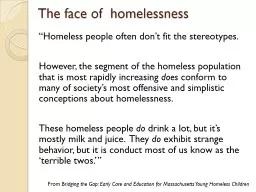

Homeless people often dont fit the stereotypes However the segment of the homeless population that is most rapidly increasing does conform to many of societys most offensive and simplistic conceptions about homelessness ID: 931698
Download Presentation The PPT/PDF document "The face of homelessness" is the property of its rightful owner. Permission is granted to download and print the materials on this web site for personal, non-commercial use only, and to display it on your personal computer provided you do not modify the materials and that you retain all copyright notices contained in the materials. By downloading content from our website, you accept the terms of this agreement.
Slide1
The face of homelessness
“Homeless people often don’t fit the stereotypes.
However
, the segment of the homeless population that is most rapidly increasing
does
conform to many of society’s most offensive and simplistic conceptions about homelessness.
These
homeless people
do
drink a lot, but it’s mostly milk and juice. They
do
exhibit strange behavior, but it is conduct most of us know as the ‘terrible twos.’”
From
Bridging the Gap: Early Care and Education for Massachusetts Young Homeless Children
Slide2True or False?
Approximately 25% of homeless children living in shelters are under the age of 5
Approximately 45% of homeless preschoolers have at least one major developmental delay
The fastest growing segment of the homeless population is single adult womenBuilding relationships is the best practice a school can develop when supporting students who are experiencing homelessness
Slide3Before enrolling and placing a student who is homeless in classes, it is best to gather all the records you can to ensure correct classroom placement, thus having them start school once you have all the information.
Many public school districts have someone in charge of school services for students experiencing homelessness
All unaccompanied youth are considered homeless
When supporting the needs of a student experiencing homelessness, schools must eliminate any educational barrier that exists or arises
McKinney Vento is a state law that gives rights to students experiencing homelessness in schools
True or False?
Slide44
Why is McKinney –Vento important?
Research on School Mobility
Students who switch schools suffer:
Psychologically
Socially
Academically
More likely to repeat grades, will have lower math/reading scores
Mobility hurts non-mobile students as well
You will hear: On average, 4-6 months to recover academic progress each time a student changes schools.
Expert panel report submitted in B.H. v. McDonald
by
Dr. Joy Rogers, Loyola University
,
1991.
Slide5Stabilize the Child’s Basic Needs
Physical Needs
Emotional Needs
Social Needs
How Schools Can Help Children Who Are Experiencing Homelessness
Slide6Stabilize the Child’s Basic Needs
Physical Needs
Emotional Needs
Social NeedsBuild RelationshipsSchool wideClassroomRecess
Family
Provide check-in’s
Two days
Two weeks
One month
How Schools Can Help Children Who Are Experiencing Homelessness
Slide7That said, here are things to think about
:
No prenatal care/low birth weight means a 9 fold increase in chance of death in first year or developmental delays
75% under 5 have one developmental delay, 44% have 2 or more delaysPhysical health is compromisedEnvironment is compromisedStress and Trauma, may be acute or chronic and can change brain chemistry: PTSD Food Insecurity
Mental Health including attachment may be affected
Exposure to Violence
Educational delays or missing pieces
Juvenile Delinquency
Attendance and Tardiness
Fatigue
Anxiety about safety (their own and their family)
Slide8Maslow’s School Hierarchy of Needs
Where and how do schools, classrooms, programs, tutoring, fit in?
What do our students need?
What do/can schools/programs do to help meet these needs?How do we help students feel: Welcome, Wanted and Safe, in our schools?
Slide9Slide10Small Group Activity
Move into groups of 3-4
Remember each students needs to feel
Welcome, Wanted, and SafeIn each group take time to brainstorm on chart paper ways to help new students feel Welcome, Wanted and Safe in your schools and classrooms.What activities/procedures can help them integrate and understand the routines, expectations, and communityBe ready to share your ideas in the larger group
Slide11Let’s talk about the
MOBILITY SHUFFLE
Slide12Processing the Mobility Shuffle
How did this make you feel?
Did it affect your learning?
Did you leave anything behind? Why or why not?What did you notice?Did you find yourself anticipating anything?How did you cope?What did you notice about the reforming of groups?What new thoughts do you have about mobile students?What can we do to support mobile students and families?